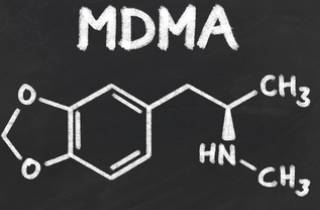Ecstasy is the textbook example of just how wrong drugs can go. Created in labs of pharmaceutical giant Merck and then outlawed, ecstasy has become the potpourri of the illicit drug world.
So, where did it all get started? And when did it gain traction as a fun drug? We explore here. Then, we invite your questions, comments, and opinions, about ecstasy at the end.
Ecstasy, The Beginning
The drug that would be known as Ecstasy was created in 1912 by two scientists working for the pharmaceutical company, Merck, in Germany. The drug was first known by its chemical name, 3,4-methylenedioxymethylamphetamine, or MDMA. It received a patent although no intended uses were mentioned in the patent filing. Merck intended to use it as a diet pill.
They later decided against developing the drug for that use so MDMA remained dormant. It is rumored the drug was used by the U.S. military in 1953. However, in the 1960s MDMA gained traction in psychotherapy. By the 70s, MDMA hit the streets as a party drug. Its popularity increased. In the 80s it was “the” club drug. Remarkably MDMA, branded “Ecstasy”, was a legal substance until 1985.
Modern Ecstasy
The ecstasy of today is not the MDMA of yesteryear. The brand name has become a generic term with little actual meaning about the chemical makeup of an individual pill. Today’s ecstasy can be a potpourri of whatever drugs the dealers decide to mix together. This impurity is part of what makes it so dangerous. Users can be consuming everything from rat poison to caffeine mixed with anything from LSD to methamphetamine with or without MDMA.
The combinations of drugs in today’s ecstasy are nearly endless. This sets victims up not only for addiction to the ecstasy high, but overdose and even death. When users do not know what they are ingesting from score to score, they won’t be able to judge the high they receive. As users take more to try to have a higher high than last time, they may inadvertently overdose on the new combination of drugs.
Your Brain On MDMA
Assuming the ecstasy someone buys actually has MDMA in it, MDMA takes about 15 minutes to reach the brain. Once in the brain, MDMA increases serotonin which is one of the brain’s feel good chemicals. The rush of serotonin helps the body feel so good it has earned the drug the nickname “the love drug.”
However, as the effects of MDMA subside, the user feels faint or dizzy and can have the chills and the sweats. As the brain comes off the flood of serotonin agitation and anxiety sets in. Plus, the effects of ecstasy on the brain are not only short-term. The brain can suffer for weeks with confusion and depression causing the user to begin craving the drug again. These after effects of MDMA can be permanent for heavy users.
Your Body On MDMA
As your brain releases extra serotonin, suddenly your natural inhibitions drop. You may feel more relaxed and open to behavior you normally would not including unprotected sex which is why it is a popular party drug. Other effects are potentially more dangerous.
For example, many users do not know one dose of MDMA can lead to death as body temperature climbs to hyperthermia levels. If it does not kill you, the extra heat can permanently damage the heart, liver, and kidneys. Other side effects include:
- elevated heart rate
- elevated blood pressure
- muscle tension
- teeth clenching
- nausea
- blurred vision
All of these side effects are especially dangerous in a club setting as users might explain them away as a crowded room or the euphoria of the party. Users who try to keep from coming down before the party is over often take more MDMA. Unfortunately the body does not metabolize MDMA quickly. Too much MDMA in the bloodstream can cause irregular heartbeats and seizures which cause death.
Half A World Away
With all the dangers of extreme doses of pure MDMA and the street drug ecstasy, it is exceptionally alarming to learn in Great Britain officials are mulling downgrading ecstasy from class A to class B. The Advisory Council on the Misuse of Drugs (ACMD), Britain’s version of the DEA, is behind the change. The downgrade will reduce penalties for users and dealers.
In contrast, the U.S. penalties for ecstasy are more severe than for any other drug. The move by the ACMD is incomprehensible considering ecstasy is the third most popular illicit drug in Great Britain thanks in part to the dominance club culture. However, the chairman of the ACMD supports the reclassification because thanks to the Internet teens now know MDMA has been shown to have medicinal value.
Fortunately for Britons, even if the ACMD does support reclassification it is unlikely the government will allow the change. The ACMD recommended cannabis receives a similar downgrade, from class B to class C, but was it was overridden by Home Secretary, Jacqui Smith.
Deadly Combinations
Of course, regular or unprescribed use of any psychoactive drug on its own is bad enough and carries risk. Still another alarming aspect to ecstasy is how eager young users are to mix it with alcohol or other drugs. The whole party scene is, of course, a huge contributing factor. A single pill chased by a shot can cause death especially if the ecstasy has been cut with other drugs.
Durham University professor Fiona Measham said she has seen a drastic shift in the attitudes of today’s club generation. Among club kids, drugs, including ecstasy, are no big deal. The attitude is bad but the combination can be deadly. Hopefully, attitudes toward ecstasy will not soften on this side of the pond.









Related Posts